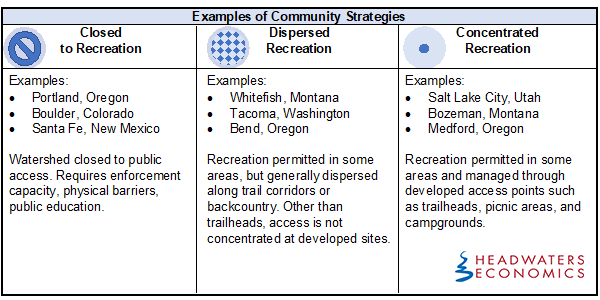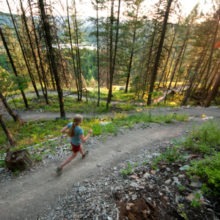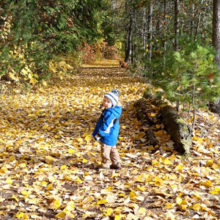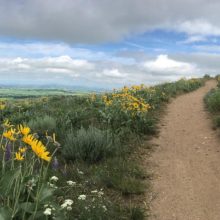- With the rising role of recreation and associated economic development, balancing the needs of protecting watersheds and clean water resources increasingly challenges many communities.
- Two primary concerns are sedimentation and erosion, and contamination from human and animal waste. Communities have found many of these concerns can be mitigated through sustainable trail construction and by providing adequate facilities for recreational users.
- Using case studies from four communities, this study reviews the strategies communities have used to protect watersheds—from prohibiting access in portions of the watershed, to allowing dispersed recreation, to permitting concentrated recreation at developed sites.
- The report concludes with five best practices for watersheds and recreation that communities can use when developing management plans to help drive success.
Balancing Watershed Protection and Recreation
Recreation can be a challenging topic for watershed managers. Protecting water quality, habitat, and forest health are always the primary objectives in municipal watersheds, but communities also value outdoor recreation for its contributions to local economies and quality of life.
Protecting water quality for growing populations is critical; growing populations want to be able to recreate in the nearby mountains. Determining when, where, and how recreation is compatible with protecting resource values varies from community to community.
Not all communities own the land that provides them with drinking water, but the places with ownership have a unique opportunity to creatively meet water quality standards and growing demands for recreation, aligning multiple community values.
Case Studies: Four Approaches to Watershed Management
This study is meant to provide communities with information about the opportunities and challenges around recreational access in municipal watersheds.
The report contains a summary of background literature about the impacts of recreation on water quality and provides case studies of four communities in the western United States that use a range of strategies to manage recreation compatibly with municipal watershed resources.
These case studies were selected because they provide examples of different management plans and different experiences that are instructive, despite different watershed and community sizes. This is not intended to be an exhaustive list of all municipalities that have considered allowing recreation.
We describe their collaborative management processes, identify the challenges they face, and offer key takeaways best practices for watersheds and recreation that may be applicable to other communities.

Strategies: Opportunities and Challenges
Communities apply a variety—and often a combination—of strategies, from prohibiting access in portions of the watershed, to allowing dispersed recreation, to permitting concentrated recreation at developed sites.
Each strategy presents its own distinct opportunities and challenges. While prohibiting all forms of recreation is a strategy in some places, it is important to note that excluding recreation is not a passive alternative and requires capacity for enforcement, monitoring, and education.

Five Best Practices for Watersheds and Recreation
Strategies for managing multiple community values in municipal watersheds are diverse, often requiring collaboration across jurisdictions and adaptive management to adjust to changing community needs, development trends, recreational demand, and ecological conditions.
Where recreation is permitted in municipal watersheds, the challenges posed to water quality are not always clear. Sedimentation, erosion, and contamination are possible but difficult to measure and correlate with recreational activity. None of the communities explored in this study has had significant problems related to recreation.
Five common best practices for watersheds and recreation that help drive success include:
- Build an early, robust public process to listen to and incorporate community values, ideas, and solutions into the watershed management plan. Understanding how outdoor recreation compares to other community values will help determine the importance of access in the watershed.
- Design a management plan proactively rather than reactively. Give thoughtful consideration to the design of where, when, and how recreation will be permitted. It is very advantageous to design and construct access in sustainable ways upfront rather than try to correct problems after an area is in use. Using the best available data, communities can identify areas with greater sensitivity or risk and their access can be restricted or limited to dispersed activities. Today’s best practices in trail design, trailhead management, and construction techniques will aid in these efforts and help protect water quality. Communities such as Sandpoint, Idaho have the advantage of being able to take the time to consider these issues and get it right the first time.
- Partner with land management agencies and others. All of the communities profiled here have strong working relationships with the U.S. Forest Service, other land management agencies, and nonprofit partners like land trusts and watershed groups. Relying on partners’ expertise in managing recreation and land can aid a community and help make the municipal land function seamlessly with adjoining recreational amenities.
- Integrate public education into the management plan. Leveraging watershed access into an opportunity for public education, stewardship, and sense of ownership pays dividends. Improving the behavior and actions of individuals through such education will help protect water quality, and educating the public will likely develop public support for watershed protection.
- Gather and monitor baseline data. Before any changes in management, take the opportunity to collect baseline data about water quality. These can be simple measurements and could be linked with public education and outreach, for example integrating school groups into the data collection. Once baseline data are established, set goals and metrics to see how management practices might affect water quality over time.
This report was made possible through the generous funding of the LOR Foundation.




